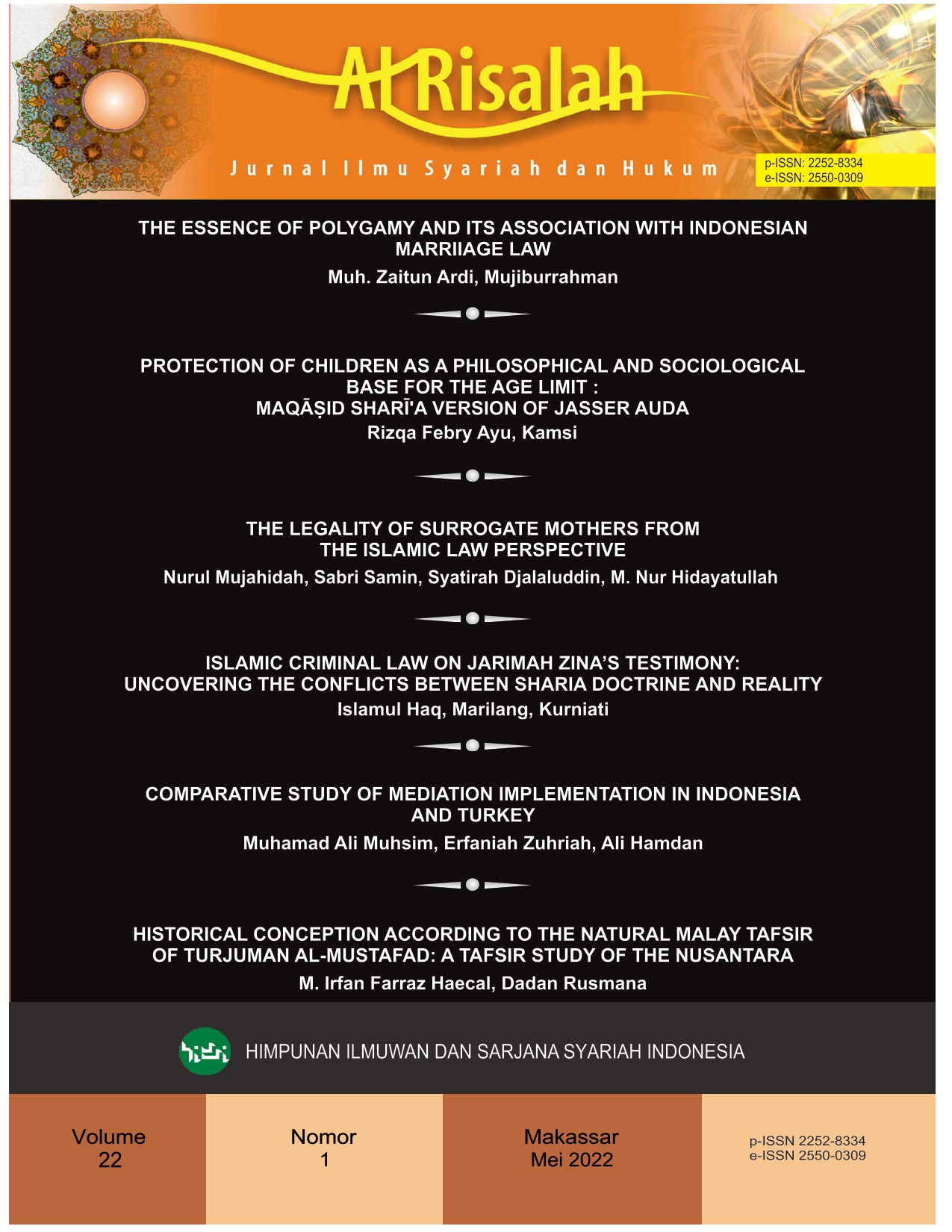THE ESSENCE OF POLYGAMY AND ITS ASSOCIATION WITH INDONESIAN MARRIAGE LAW
Abstrak
This study aims to explain the substance of the possibility of polygamy and its relevance to Indonesian marriage law. Polygamy has existed in the pre -Islamic era until today. Islam does not forbid and advocate polygamy, but Islam came to regulate and limit the rules of Polygamy. The substance of polygamy can be seen from the context or nash of polygamy as well as Arab history in the Jahiliyyah period. Contextually Nash, Polygamy is allowed for widows and orphans with a limit of four wives and conditions of fairness. This verse was revealed because many Muslims died during the battle of Uhud which affected the high number of widows and orphans left to die with worrying conditions in terms of economic, social and educational. women are the property of their own wealth. So with this response, women are likened to animals and goods that can be traded regardless of a woman's rights. Basic Law of Polygamy in Islam Qur’an which puts forward the principles of justice and welfare in emergencies. The relevance of the provisions on polygamy in Marriage and the Compilation of Islamic Law is not fully in line with the substance or nash of the ability of polygamy in Islam but has led to the basis of Qur’an with the principle of justice, creating benefits and prevent damage. The reason for the possibility of polygamy is that there are more women than men and if monogamy continues to be maintained then there will be many practices of prostitution. This study uses a qualitative approach with the type of library research, which is a series related to the methods of collecting library data, reading, taking notes and processing research materials. The approach of seeking information from the problem that is being tried to find the answer. So, the theory of approach used is the legal approach, the normative approach and the descriptive approach. The subject of this thesis research is a descriptive approach, which describes polygamy in the Marriage Law in Indonesia from the perspective of Islamic jurisprudence. Furthermore, it examines the relevance of the provisions of polygamy in the Marriage and the Compilation of Islamic Law because it is not fully in line with the substance or text of the permissibility of polygamy in Islam.
Referensi
Ahmad, Wahid Syarifuddin. “Status Poligami Dalam Hukum Islam (Telaah Atas Berbagai Kesalahan Memahami Nas Dan Praktik Poligami).” Jurnal Al-Ahwal 6, no. 1 (2013): 57–70.
Al-Krenawi, Alean. “Polygamous Marriages: An Arab-Islamic Perspective.” In Couple Relationships in a Global Context, 193–205, 2020. https://doi.org/10.1007/978-3-030-37712-0_12.
Al-Razi, Fahruddin. Mafatih Al-Gaib. Beirut, 2000.
Andaryuni, Lilik. “Poligami Dalam Hukum Keluarga Di Dunia Islam.” Jurnal Sipakallebi 1, no. 1 (2013): 107.
Ardhian, Reza Fitria, Satrio Anugrah, and Setyawan Bima. “Poligami Dalam Hukum Islam Dan Hukum Positif Indonesia Serta Urgensi Pemberian Izin Poligami Di Pengadilan Agama.” Jurnal Privat Law 2, no. 2 (2015): 101–7.
Cahyani, Andi Intan. “Poligami Dalam Perspektif Hukum Islam.” Jurnal Al-Qadau: Peradilan Dan Hukum Keluarga Islam 5, no. 2 (2018): 271. https://doi.org/10.24252/al-qadau.v5i2.7108.
Darmawijaya, Edi. “Poligami Dalam Hukum Islam Dan Hukum Positif.” Jurnal Gender Equality 1, no. 1 (2015): 27–38.
Elkarimah, Mia Fitria. “Telaah Poligami Perspektif Syahrur; KHI Dan Undang-Undang Perkawinan Indonesia.” Jurnal Hukum Islam 18, no. 1 (2018): 133–46.
Erma, Zetria. “Penegakan Hukum Terhadap Pelanggaran Beristri Lebih Dari Satu (Poligami) Bagi Pegawai Negeri Sipil (PNS).” Ready Star, 2019, 389–93. http://ptki.ac.id/jurnal/index.php/readystar/article/view/81.
Hafiz, Kahfi Adlan, and Intan Lestari. “Diverity of Views on The Inequality of Men’s Power Relations Over Women in The Practice of Polygamy in Indonesia.” ASEAN/Asian Academic Society International Conference Proceeding Series, no. December 1924 (2019): 502–9.
Hermanto, Agus. “Islam, Poligami Dan Perlindungan Kaum Perempuan.” Kalam: Jurnal Studi Agama Dan Pemikiran Islam 9, no. 1 (2015): 165–86. https://doi.org/https://doi.org/10.24042/klm.v9i1.326.
Imanullah, Rijal. “Poligami Dalam Hukum Indonesia (Analisis Terhadap Putusan Pengadilan Agama No.915/Pdt.G/2014/PA.BPP Tentang Izin Poligami).” Al-Madzahib 15, no. 1 (2006): 104–27.
Janeko. “Studi Eksplorasi Hukum Poligami Di Berbagai Negara Muslim.” Jurnal Ummul Qura 10, no. 2 (2007): 58.
Kathir, Ibn. The Life of Propher Muhammad. Journal of Chemical Information and Modeling. Vol. 53, 2019.
Khoirin, Nur. “Menyoal Izin Poligami Bagi PNS.” Jurnal Studi Gender Dan Anak 5, no. 2 (2010): 232.
Lapatantja, Nanda Arisqa, and Muammar Bakry. “Comparative Analyses of Maliki and Hanbali Thought on Waqf Istibdal.” Mazahibuna: Jurnal Perbandingan Mazhab 3, no. 1 (2021): 49–60. http://journal.uin-alauddin.ac.id/index.php/mjpm/article/view/21129.
Madu, Tofan. “Praktek Poligami Dalam Perspektif Hukum Islam.” Jurnal Lex Privatum 8, no. 1 (2014): 27–35.
Mu’in, Abdul, and Ahmad Khotibul Umam. “Eksistensi Kompilasi Hukum Islam Dalam Hukum Positif.” Jurnal Risalah 1, no. 1 (2016): 69.
Naro, Wahyuddin, Abdul Syatar, Muhammad Majdy Amiruddin, Islamul Haq, Achmad Abubakar, and Chaerul Risal. “Shariah Assessment Toward the Prosecution of Cybercrime in Indonesia.” International Journal of Criminology and Sociology 9 (2020): 572–86. https://doi.org/https://doi.org/10.6000/1929-4409.2020.09.5.
Nurcahaya, Mrs, Mr Akbarizan, and Mrs Sri Murhayati. “Punishment for Polygamy Doer in The Perspective of Islamic Law in Indonesia.” In International Conference on Culture and Language in Southeast Asia (, 154:47–50, 2018. https://doi.org/10.2991/icclas-17.2018.12.
Nurmila, Nina. “Polygamous Marriages in Indonesia and Their Impacts on Women’s Access to Income and Property.” Al-Jami’ah 54, no. 2 (2016): 427–46. https://doi.org/10.14421/ajis.2016.542.427-446.
Rahmi. “Poligami : Penafsiran Surah An-Nisa 4 : 3.” Jurnal Ilmiah Kajian Gender 5, no. 1 (2015): 117.
Santoso, Dri, and Muhammad Nasruddin. “Poligamy in Indonesia and Its Relevance to the Protection Od Women and Children in the Perspective of Islamic Law Philosophy.” AKADEMIKA: Jurnal Pemikiran Islam 26, no. 1 (2021): 121–26. https://doi.org/https://doi.org/10.32332/akademika.v26i1.2406.
Sugitanata, Arif. “Product Renewal in the Field of Family Law in Indonesia.” Law and Justice 6, no. 1 (2021): 62–79. https://doi.org/10.23917/laj.v6i1.10699.
Syamsuddin, Syamsuddin, Zainal Abidin, and Syahabuddin Syahabuddin. “Polygamy from Quraish Shihab’s View in the Tafsir Al-Mishbah.” International Journal of Contemporary Islamic Law and Society 3, no. 2 (2021): 1–18. https://doi.org/10.24239/ijcils.vol3.iss2.31.
Zeitzen, Miriam Koktvedgaard. “Polygamy (Polygyny, Polyandry).” The International Encyclopedia of Anthropology, 2018. https://doi.org/https://doi.org/10.1002/9781118924396.wbiea1377.
##submission.copyrightStatement##
##submission.license.cc.by4.footer##

